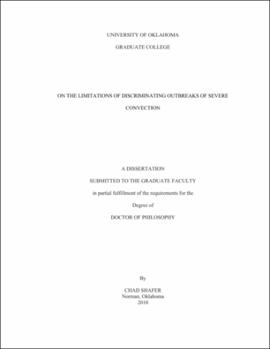| dc.contributor.advisor | Richman, Michael B||Leslie, Lance M | |
| dc.creator | Shafer, Chad | |
| dc.date.accessioned | 2019-04-27T21:31:45Z | |
| dc.date.available | 2019-04-27T21:31:45Z | |
| dc.date.issued | 2010 | |
| dc.identifier | 9927176702042 | |
| dc.identifier.uri | https://hdl.handle.net/11244/318918 | |
| dc.description.abstract | Although much has been learned in recent decades regarding the synoptic and subsynoptic environments associated with major tornado outbreaks, very little research has been conducted using a large sample of outbreak cases to distinguish major tornado outbreaks from less significant events. Preliminary investigations suggested that there were systematic differences between the synoptic-scale environments of tornado outbreaks and primarily nontornadic outbreaks, and that synoptic-scale processes occurring up to three days in advance of the outbreaks were a useful means of discriminating the events. Subsequent investigations showed that the time of year in which the outbreaks occurred played a non-negligible role in the discrimination of these events, but that precursor synoptic-scale environments could be used as initial data in mesoscale models to simulate outbreak environments that were systematically different between the two types of outbreaks. | |
| dc.description.abstract | Because of the promising results of these initial studies, research encompassing all types of outbreaks should be investigated, as most outbreaks of severe convection cannot be classified readily as major tornado outbreaks or primarily nontornadic outbreaks. This is the focus of the present study. For this work to be implemented, a new scheme to rank and classify severe weather outbreaks of any type must be developed. Initial work implemented a multivariate, linear-weighted index to rank the events based on the characteristics of the severe reports during individual 24-h periods. Although the technique was relatively effective in the identification of the most significant events, days with multiple regionally distinct clusters of severe reports were considered as single events. A modification to this ranking scheme will be introduced in this study to account for these days, using a kernel density estimation technique. Two objective techniques (the areal coverage and principal component analysis methods) will be introduced and their ability to discriminate major severe weather outbreaks from less significant events will be compared. Finally, comparison of these objective techniques to current operational forecasting will be examined to determine the potential utility of these methods in future forecasts. | |
| dc.description.abstract | The results of this work suggest that there is reasonable accuracy and skill in discriminating major tornado outbreaks from less significant events. However, a substantial false alarm problem exists with any of the objective techniques developed, which is also observed in current operational forecasts. Implications of these findings and potential topics for future research will be discussed. | |
| dc.format.extent | 172 pages | |
| dc.format.medium | application.pdf | |
| dc.language | en_US | |
| dc.relation.requires | Adobe Acrobat Reader | |
| dc.subject | Tornadoes | |
| dc.subject | Synoptic meteorology | |
| dc.subject | Convection (Meteorology) | |
| dc.title | On the Limitations of Discriminating Outbreaks of Severe Convection | |
| dc.type | text | |
| dc.type | document | |
| dc.thesis.degree | Ph.D. | |
| ou.group | College of Atmospheric & Geographic Sciences::School of Meteorology | |
